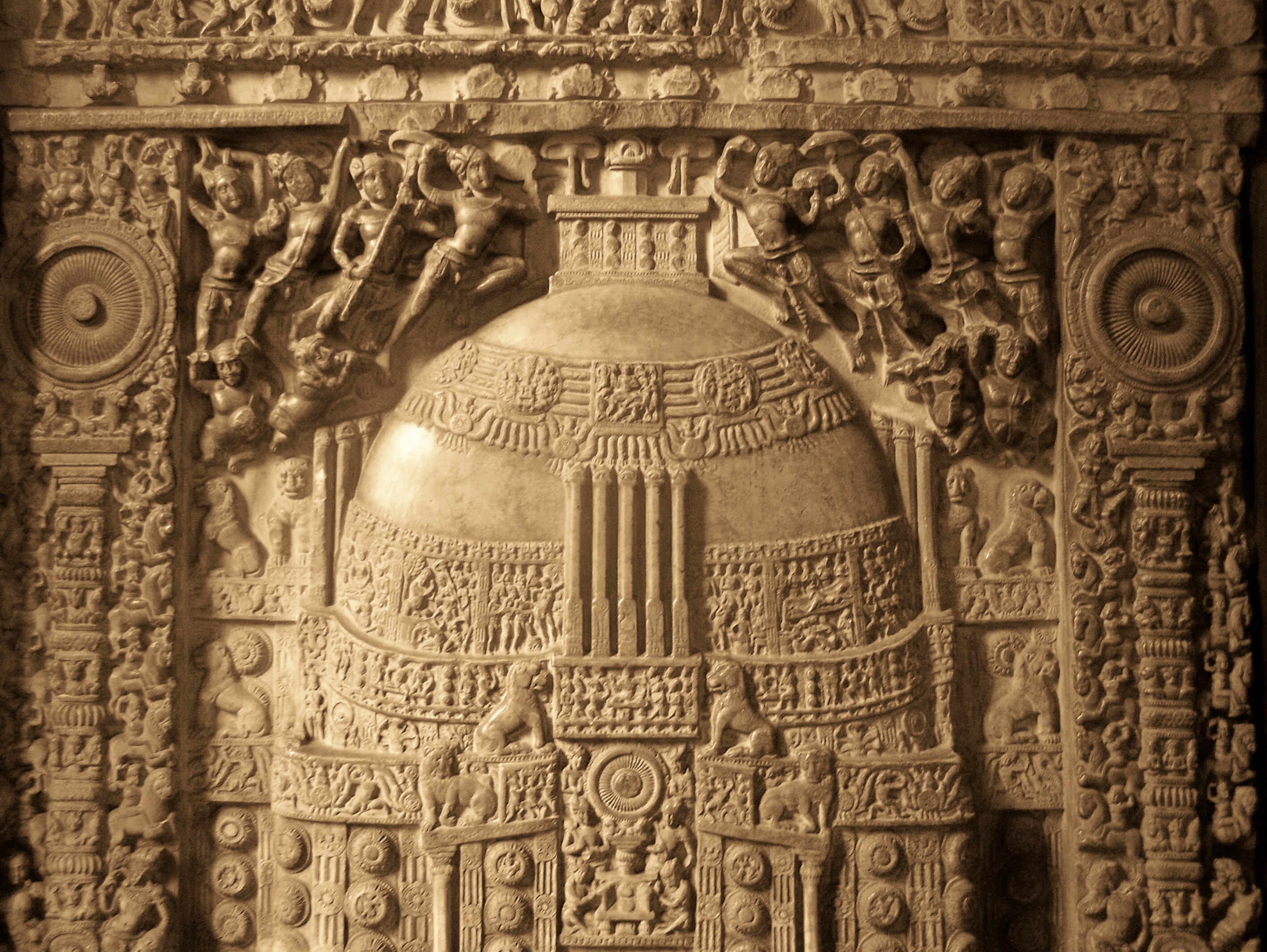|
Ekayāna
Ekayāna (, ) is a Sanskrit word that means "one path" or "one vehicle". It is used in the Upanishads and the Mahāyāna sūtras. Upanishads In the ''Brihadaranyaka Upanishad'', "ekayāna" took on special significance as a metaphor for a spiritual journey. The phrase ''vedānāṃ vāk ekayānam'' translates approximately to "the one destination of the Vedas is the spirit of the word". Mahayana Buddhism Ekayāna sutras of primary influence are the ''Lotus Sutra'', the '' Śrīmālādevī Siṃhanāda Sūtra'',Buswell, Robert E., Lopez, Donald S. Jr. (2014). The Princeton Dictionary of Buddhism, Princeton: Princeton University Press, p.281-2 the ''Ratnagotravibhāga,'' and the Tathāgatagarbha sūtras,Grosnick, William (1981)Nonorigination and Nirvana in the Early Thatagatagarbha Literature Journal of the International Association of Buddhist Studies 4/2, 34 which also include the '' Tathāgatagarbha Sūtra'', the ''Mahāyāna Mahāparinirvāṇa Sūtra,'' and the '' Aṅgulimāl� ... [...More Info...] [...Related Items...] OR: [Wikipedia] [Google] [Baidu] |
Bodhisattva
In Buddhism, a bodhisattva is a person who has attained, or is striving towards, '' bodhi'' ('awakening', 'enlightenment') or Buddhahood. Often, the term specifically refers to a person who forgoes or delays personal nirvana or ''bodhi'' in order to compassionately help other individuals reach Buddhahood. In the Early Buddhist schools, as well as modern Theravāda Buddhism, bodhisattva (or bodhisatta) refers to someone who has made a resolution to become a Buddha and has also received a confirmation or prediction from a living Buddha that this will come to pass. In Theravāda Buddhism, the bodhisattva is mainly seen as an exceptional and rare individual. Only a few select individuals are ultimately able to become bodhisattvas, such as Maitreya. In Mahāyāna Buddhism, a bodhisattva refers to anyone who has generated '' bodhicitta'', a spontaneous wish and compassionate mind to attain Buddhahood for the benefit of all sentient beings. Mahayana bodhisattvas are spiritua ... [...More Info...] [...Related Items...] OR: [Wikipedia] [Google] [Baidu] |
Tendai
, also known as the Tendai Dharma Flower School (天台法華宗, ''Tendai hokke shū,'' sometimes just ''Hokkeshū''), is a Mahāyāna Buddhist tradition with significant esoteric elements that was officially established in Japan in 806 by the Japanese monk Saichō. The Tendai school, which has been based on Mount Hiei since its inception, rose to prominence during the Heian period (794–1185). It gradually eclipsed the powerful Hossō school and competed with the rival Shingon school to become the most influential sect at the Imperial court. By the Kamakura period (1185–1333), Tendai had become one of the dominant forms of Japanese Buddhism, with numerous temples and vast landholdings. During the Kamakura period, various monks left Tendai to found new Buddhist schools such as Jōdo-shū, Jōdo Shinshū, Nichiren-shū and Sōtō Zen. The destruction of the head temple of Enryaku-ji by Oda Nobunaga in 1571, as well as the geographic shift of the capital away from ... [...More Info...] [...Related Items...] OR: [Wikipedia] [Google] [Baidu] |
Tiantai
Tiantai or T'ien-t'ai () is an East Asian Buddhist school of Mahāyāna Buddhism that developed in 6th-century China. Drawing from earlier Mahāyāna sources such as Madhyamaka, founded by Nāgārjuna, who is traditionally regarded as the first patriarch of the school, Tiantai Buddhism emphasizes the "One Vehicle" () doctrine derived from the influential '' Lotus Sūtra'', as well as the philosophy of its fourth patriarch, Zhiyi (538–597 CE), the principal founder of the tradition. Brook Ziporyn, professor of ancient and medieval Chinese religion and philosophy, states that Tiantai Buddhism is "the earliest attempt at a thoroughgoing Sinitic reworking of the Indian Buddhist tradition." According to Paul Swanson, scholar of Buddhist studies, Tiantai Buddhism grew to become "one of the most influential Buddhist traditions in China and Japan." Tiantai is sometimes also called "The Dharma Flower School" (), after its focus on the '' Lotus Sūtra'', whose Chinese title tra ... [...More Info...] [...Related Items...] OR: [Wikipedia] [Google] [Baidu] |
Satipaṭṭhāna Sutta
The ''Satipaṭṭhāna Sutta'' ( Majjhima Nikaya 10: ''The Discourse on the Establishing of Mindfulness''), and the subsequently created Mahāsatipaṭṭhāna Sutta (Dīgha Nikāya 22: ''The Great Discourse on the Establishing of Mindfulness''), are two of the most celebrated and widely studied discourses in the Pāli Canon of Theravada Buddhism, acting as the foundation for contemporary '' vipassana'' meditation practice. The Pāli texts of the Satipaṭṭhāna Sutta and the Mahāsatipaṭṭhāna Sutta are largely similar in content; the main difference being a section about the Four Noble Truths (Catu Ariya Sacca) in the Observation of Phenomena (Dhammānupassana), which is greatly expanded in the Mahāsatipaṭṭhāna Sutta. These suttas (discourses) stress the practice of sati (mindfulness) "for the purification of beings, for the overcoming of sorrow and lamentation, for the extinguishing of suffering and grief, for walking on the path of truth, for the realization of ' ... [...More Info...] [...Related Items...] OR: [Wikipedia] [Google] [Baidu] |
Yana (Buddhism)
Yāna (Sanskrit: यान and Pāli: "vehicle") refers to a mode or method of spiritual practice in Buddhism. It is claimed they were all taught by the Buddha, Gautama Buddha in response to the various capacities of individuals. On an outwardly conventional level, the teachings and practices may appear contradictory, but ultimately they all have the same goal. Nomenclature, etymology and orthography In form, yāna is a neuter noun derived from the Sanskrit root yā- meaning to "go to" or "move" or "reach". The suffix employed to form this noun may have different values: while primarily yāna is understood to refer to the means (kara.na) through which one goes to/ reaches a location, it may technically also refer to the action itself (bhāva). Yāna is therefore primarily a "vehicle", in most contexts relevant to the Buddhist doctrine of three yānas. "Vehicle" is often used as a preferred translation as the word that provides the least in the way of presuppositions about the m ... [...More Info...] [...Related Items...] OR: [Wikipedia] [Google] [Baidu] |
Guifeng Zongmi
Guifeng Zongmi () (780–1 February 841) was a Tang dynasty Chinese Buddhist monk and scholar who is considered a patriarch of both the Huayan school and Chan Buddhism. Zongmi wrote a number of works on several Mahayana Sutras, Chan and Huayan, and he also discussed Taoism and Confucianism. His works are a major source for studying the various Chan schools of the Tang. Zongmi was deeply interested in both the practical and doctrinal aspects of Mahayana Buddhism, especially the teachings of the '' Sutra of Perfect Enlightenment'' and the '' Mahayana Awakening of Faith''. Zongmi's work is concerned with harmonizing the various Chan teachings (especially the doctrines of sudden awakening and original enlightenment) with other Chinese Buddhist traditions, especially Huayan, though he also drew on the work of Tiantai Zhiyi in his ritual works. His philosophy attempts to create a comprehensive worldview that includes and sublimates all Buddhist and non-buddhist teachings of his t ... [...More Info...] [...Related Items...] OR: [Wikipedia] [Google] [Baidu] |
Lotus Sutra
The ''Lotus Sūtra'' (Sanskrit: ''Saddharma Puṇḍarīka Sūtram'', ''Sūtra on the White Lotus of the True Dharma'', zh, p=Fǎhuá jīng, l=Dharma Flower Sutra) is one of the most influential and venerated Buddhist Mahāyāna sūtras. It is the main scripture on which the Tiantai along with its derivative schools, the Japanese Tendai and Nichiren, Korean Cheontae, and Vietnamese Thiên Thai schools of Buddhism were established. It is also influential for other East Asian Buddhist schools, such as Zen. According to the British Buddhologist Paul Williams, "For many Buddhists in East Asia since early times, the ''Lotus Sūtra'' contains the final teaching of Shakyamuni Buddha—complete and sufficient for salvation." The American Buddhologist Donald S. Lopez Jr. writes that the ''Lotus Sūtra'' "is arguably the most famous of all Buddhist texts," presenting "a radical re-vision of both the Buddhist path and of the person of the Buddha." Two central teachings ... [...More Info...] [...Related Items...] OR: [Wikipedia] [Google] [Baidu] |
Śrīmālādevī Siṃhanāda Sūtra
The ''Śrīmālādevī Siṃhanāda Sūtra'' (, '' of Queen Śrīmālā'') is one of the main early Mahāyāna Buddhist texts belonging to the Tathāgatagarbha sūtras that teaches the doctrines of Buddha-nature and "One Vehicle" through the words of the Indian queen Śrīmālā. After its composition, this text became the primary scriptural advocate in India for the universal potentiality of Buddhahood. History Brian Edward Brown, a specialist in Buddha-nature doctrines, writes that the composition of the ''Śrīmālādevī Siṃhanāda Sūtra'' occurred during the Īkṣvāku Dynasty in the 3rd century CE as a product of the Caitika schools of the Mahāsāṃghikas. Alex Wayman has outlined eleven points of complete agreement between the Mahāsāṃghikas and the ''Śrīmālā'', along with four major arguments for this association. Anthony Barber also associates the earlier development of the '' Tathāgatagarbha Sūtra'' with the Mahāsāṃghikas, and concludes that the M ... [...More Info...] [...Related Items...] OR: [Wikipedia] [Google] [Baidu] |
Laṅkāvatāra Sūtra
The ''Laṅkāvatāra Sūtra'' (Sanskrit: लङ्कावतारसूत्रम्, "Discourse of the Descent into Laṅkā", , Chinese: 入楞伽經) is a prominent Mahayana Buddhist sūtra. It is also titled ''Laṅkāvatāraratnasūtram'' (''The Jewel Sutra of the Entry into Laṅkā,'' Gunabhadra's Chinese title: 楞伽阿跋多羅寶經 léngqié ābáduōluó bǎojīng) and ''Saddharmalaṅkāvatārasūtra'' (''The Sutra on the Descent of the True Dharma into Laṅkā''). A subtitle to the sutra found in some sources is "''the heart of the words of all the Buddhas''" (一切佛語心 yiqiefo yuxin, Sanskrit: ''sarvabuddhapravacanahṛdaya''). The ''Laṅkāvatāra'' recounts a teaching primarily between Gautama Buddha and a bodhisattva named Mahāmati ("Great Wisdom"). The sūtra is set in mythical Laṅkā, ruled by Rāvaṇa, the king of the rākṣasas. The ''Laṅkāvatāra'' discusses numerous Mahayana topics, such as Yogācāra philosophy of mind-only (' ... [...More Info...] [...Related Items...] OR: [Wikipedia] [Google] [Baidu] |
Mahāyāna Sūtras
The Mahayana sutras are Buddhist texts that are accepted as wikt:canon, canonical and authentic Buddhist texts, ''buddhavacana'' in Mahayana, Mahayana Buddhist sanghas. These include three types of sutras: Those spoken by the Buddha; those spoken through the Buddha's blessings; and those spoken through mandate. They are largely preserved in Sanskrit manuscripts, and in translations such as the Tibetan Buddhist canon, and Chinese Buddhist canon. Several hundred Mahāyāna sutras survive in Sanskrit, Tibetan and Chinese translations. The Buddhist scholar Asanga classified the Mahāyāna sūtras as part of the ''Bodhisattva Tripiṭaka'', a collection of texts meant for bodhisattvas.Boin-Webb, Sara (tr). Rahula, Walpola (tr). Asanga. ''Abhidharma Samuccaya: The Compendium of Higher Teaching.'' 2001. pp. 199–200 Buddhists consider the most important Mahayana sutras to be the spoken teachings of Gautama Buddha, Shakyamuni Buddha. These were quickly recorded one year following his Ma ... [...More Info...] [...Related Items...] OR: [Wikipedia] [Google] [Baidu] |
Dazu Huike
Dazu Huike (487–593; ) is considered the Second Patriarch of Chan Buddhism and the twenty-ninth since Gautama Buddha. He was the successor to Bodhidharma. Biography Sources As with most of the early Chán patriarchs, very little firm data is available about his life. The earliest extant biography of the Chán patriarchs is the Biographies of Eminent Monks (519) () and its sequel, Further Biographies of Eminent Monks () (645) by Tao-hsuan (?-667). The following biography is the traditional Chan biography as handed down throughout the centuries, including the ''Denkoroku'' by Zen Master Keizan Jokin (1268–1325). Life The Hsu kao-seng chuan says that Huike was born in Hu-lao (Sishui, modern Xingyang, Henan) and his secular name was Shénguāng (神光, Wade–Giles: Shen-kuang; Japanese: Shinko). A scholar in both Buddhist scriptures and classical Chinese texts, including Taoism, Huike was considered enlightened but criticised for not having a teacher. He met his teacher, Bo ... [...More Info...] [...Related Items...] OR: [Wikipedia] [Google] [Baidu] |
Sacred Books Of The East
The ''Sacred Books of the East'' is a monumental 50-volume set of English translations of Asian religious texts, edited by Max Müller and published by the Oxford University Press between 1879 and 1910. It incorporates the essential sacred texts of Hinduism, Buddhism, Taoism, Confucianism, Zoroastrianism, Jainism, and Islam. All of the books are in the public domain in the United States, and most or all are in the public domain in many other countries. Electronic versions of all 50 volumes are widely available online. References External links {{wikisource, Sacred Books of the East, ''Sacred Books of the East''''Sacred Books of the East'' on archive.org (html) [...More Info...] [...Related Items...] OR: [Wikipedia] [Google] [Baidu] |






